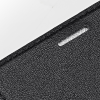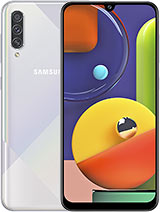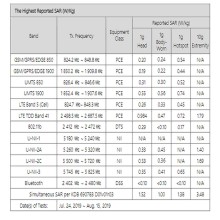Samsung Galaxy A50S Radiation Levels
| Radiation Levels | Head | Body | Hot Spot |
|---|---|---|---|
| Cellular Only | 0.98 W/kg | 0.56 W/kg | 0.74 W/kg |
| Wi-Fi + Cellular | 1.52 W/kg | 1.00 W/kg | 1.38 W/kg |
Samsung Galaxy A50s SAR Level Summary:
The cellular transmission SAR values for the Samsung Galaxy A50s (FCC ID A3LSMA507FN) are 0.98 W/kg (watts per kilogram) at the head and 0.56 W/kg when worn on the body. The hotspot/Airplay SAR level is 0.74 W/kg. The simultaneous transmission SAR values for Galaxy A50S (cellular plus Wi-Fi) is 1.52 W/kg at the head, 1.00 W/kg when worn on the body, and 1.38 W/kg when used as a hotspot simultaneously with other transmitters active.
Galaxy A50s
| Select a phone to compare Galaxy A50s SAR levels to other popular phones |
| Cell Phone Usage & Radiation Exposure | ||||||||||||
Samsung Galaxy A50S Safety Tip:How Much Will Turning Off Wi-Fi and Bluetooth Reduce Radiation?This SAR chart reveals how turning off Wi-Fi and Bluetooth on your Samsung Galaxy A50S can significantly reduce your exposure to radiation. Our SAR comparison chart shows that by simply turning off Wi-Fi and Bluetooth transmitters, you can lower the RF radiation exposure to your head by 35.3%, and you can lower exposure to the body by 44%, when considering these differences between cellular-only (Wi-Fi/Bluetooth OFF) and simultaneous use exposure (Wi-Fi/Bluetooth ON), a wise way to reduce excessive phone radiation is to tap off unnecessary transmitters when not in use! Additionally, when using your phone as a hotspot, turning off Bluetooth can reduce your exposure by up to 86.5% according to the FCC SAR report for device number A3LSMA507FN. Samsung Galaxy A50S SAR Levels
|
Key Takeaways
- Children vs Adults: Children have higher SAR levels due to thinner skulls and developing tissues, making them more vulnerable to radiation.
- Wi-Fi Impact: Simultaneous use of cellular and Wi-Fi transmission increases SAR levels for all age groups.
- Precautionary Measures: Using radiation protection products like QuantaCase can help mitigate these risks, especially for younger users.
By understanding these differences, parents and guardians can make informed decisions to better protect their children from excessive microwave radiation exposure, emphasizing the need for safer smartphone usage practices and protective accessories like QuantaCase.

| Children vs Adults Radiation Exposure |
Avoid Excessive galaxy-a50s Cell Phone Radiation!
To minimize the potential health risks associated with cell phone radiation, it’s important to reduce exposure as much as possible. This can be achieved by using hands-free devices and keeping the phone away from the body, as well as by using a phone case with built-in radiation shielding technology.
The best example is the RF Safe® galaxy-a50s QuantaCase™ RFS1. This case is designed to deflect the strongest line-of-sight radiation away from the body while not obstructing the phone’s antenna. RF shielding technology reduces excessive radiation exposure across a wide range of radio frequencies, including 5G, Wi-Fi, and cellular. Additionally, the case features an integrated single-slot RFID-blocking wallet for added security.
The QuantaCase RFS1 provides RFID and anti-radiation protection without any conductive or signal-impeding components in the back of the case, allowing the phone to operate at its lowest possible output level and reducing the amount of harmful radiation emitted. The case also protects the phone from scratches, cracks, and dings.
To use the RF Safe® galaxy-a50s QuantaCase™ RFS1 effectively, it’s recommended to always close the front flip cover and use the speakerphone when privacy is not an issue. When storing in a pocket, face the front flap towards the body to deflect the strongest line-of-sight radiation. When texting, fold the flap behind the phone to shield the back while held in hand.
It’s important to keep in mind that maintaining a distance from the phone is the best way to reduce EMF exposure. However, using a phone case with built-in radiation shielding technology like the RF Safe® galaxy-a50s QuantaCase™ RFS1 can provide an extra layer of protection in an ultra-thin design.
The Specific Absorption Rate (SAR) of a mobile device measures the amount of radio frequency energy absorbed by the body during device usage.
The SAR values for the galaxy-a50s (FCC ID A3LSMA507FN) are as follows:
- 0.98 W/kg when held at the head with cellular transmission only
- 0.56 W/kg when worn on the body with cellular transmission only
- 0.74 W/kg when used as a Hotspot or Airplay
- 1.52 W/kg when held at the head with simultaneous cellular and Wi-Fi transmission
- 1 W/kg when worn on the body with simultaneous cellular and Wi-Fi transmission
- 1.38 when used as a Hotspot simultaneously with other transmitters active.
Samsung Galaxy A50S - SAR Levels
FCC SAR Levels
-
FCC Approval Date
This is the date the phone SAR test was completed before the phone's release to the public as required by law. 28 August 2019
-
FCC ID
The FCC ID is the code used to register a device for FCC compliance A3LSMA507FN
- FCC Report Link A direct link to the FCC's website for confirming SAR levels that are listed on our website - We did the homework for you!
-
US SAR Ratings
USA Legal Limit is 1.6 W/kg USA Legal Limit is 1.6 W/kg - FCC SAR testing is measured in watts per kilogram (or W/kg) averaged over ONE gram of simulated biological tissue.
-
Head SAR Level
SAR test when held against your head when only using cellular service. Wifi and other transmitter are NOT active 0.984 W/kg
-
Body SAR Level
SAR test when held against your body only using cellular service. Wifi and other transmitter are NOT active 0.56 W/kg
-
Product Specific Use
SAR test when held against your body only using the phone as a hotspot. Cellular and other transmitter are NOT active 0.74 W/kg
-
Simultaneous Transmission
The highest possible SAR recorded with ALL transmitters active, Cellular, WiFi, and Hotspot 1.52 W/kg
-
Simultaneous Head
The highest possible SAR test when held against your HEAD with cellular and WiFi transmitters active, 1.52 W/kg
-
Simultaneous Body
The highest possible SAR test when held against your BODY with cellular and WiFi transmitters active, 1.00 W/kg
-
Hotspot SAR
The highest possible SAR test when held against your BODY using the phone as a hotspot with cellular and WiFi transmitters active, 1.38 W/kg
EU SAR Level
-
EU SAR Ratings
EU Legal Limit is 2.0 W/kg
-
Head SAR Level
0.43 W/kg (head)
-
Body SAR Level
1.55 W/kg (body)
Versions: SM-A507FN/DS (Global); SM-A507F/DS (Vietnam); SM-A5070 (Hong Kong, China)
| Network | Technology | GSM / HSPA / LTE |
|---|---|---|
| 2G bands | GSM 850 / 900 / 1800 / 1900 – SIM 1 & SIM 2 (dual-SIM model only) | |
| 3G bands | HSDPA 850 / 900 / 1900 / 2100 | |
| 4G bands | LTE band 1(2100), 3(1800), 5(850), 7(2600), 8(900), 20(800), 28(700), 38(2600), 40(2300), 41(2500) | |
| Speed | HSPA, LTE-A |
| Launch | Announced | 2019, August |
|---|---|---|
| Status | Available. Released 2019, September |
| Body | Dimensions | 158.5 x 74.5 x 7.7 mm (6.24 x 2.93 x 0.30 in) |
|---|---|---|
| Weight | 169 g (5.96 oz) | |
| Build | Glass front (Gorilla Glass 3), plastic back, plastic frame | |
| SIM | Single SIM (Nano-SIM) or Dual SIM (Nano-SIM, dual stand-by) |
| Display | Type | Super AMOLED capacitive touchscreen, 16M colors |
|---|---|---|
| Size | 6.4 inches, 100.5 cm2 (~85.1% screen-to-body ratio) | |
| Resolution | 1080 x 2340 pixels, 19.5:9 ratio (~403 ppi density) | |
| Protection | Corning Gorilla Glass 3 |
| Platform | OS | Android 9.0 (Pie), upgradable to Android 10.0; One UI 2.0 |
|---|---|---|
| Chipset | Exynos 9611 (10nm) | |
| CPU | Octa-core (4×2.3 GHz Cortex-A73 & 4×1.7 GHz Cortex-A53) | |
| GPU | Mali-G72 MP3 |
| Memory | Card slot | microSDXC (dedicated slot) |
|---|---|---|
| Internal | 64GB 4GB RAM, 128GB 4GB RAM, 128GB 6GB RAM | |
| UFS 2.1 |
| Main Camera | Triple | 48 MP, f/2.0, 26mm (wide), 1/2.0″, 0.8m, PDAF 8 MP, f/2.2, 13mm (ultrawide), 1/4.0″, 1.12m 5 MP, f/2.2, (depth) |
|---|---|---|
| Features | LED flash, panorama, HDR | |
| Video | 2160p@30fps, 1080p@30fps |
| Selfie camera | Single | 32 MP, f/2.0, 25mm (wide), 1/2.8″, 0.8m |
|---|---|---|
| Features | HDR | |
| Video | 1080p@30fps |
| Sound | Loudspeaker | Yes |
|---|---|---|
| 3.5mm jack | Yes |
| Comms | WLAN | Wi-Fi 802.11 a/b/g/n/ac, dual-band, Wi-Fi Direct, hotspot |
|---|---|---|
| Bluetooth | 5.0, A2DP, LE | |
| GPS | Yes, with A-GPS, GLONASS, GALILEO, BDS | |
| NFC | Yes (market/region dependent) | |
| Radio | FM radio | |
| USB | 2.0, Type-C 1.0 reversible connector, USB On-The-Go |
| Features | Sensors | Fingerprint (under display, optical), accelerometer, gyro, proximity, compass |
|---|---|---|
| ANT+ |
| Battery | Non-removable Li-Po 4000 mAh battery | |
|---|---|---|
| Charging | Fast battery charging 15W |
| Misc | Colors | Prism Crush Black, Prism Crush White, Prism Crush Green, Prism Crush Violet2 |
|---|---|---|
| Models | SM-A507F, SM-A507FN, SM-A5070 | |
| SAR EU | 0.43 W/kg (head) 1.55 W/kg (body) | |
| Price | $ 249.99 / £ 210.99 / ₹ 14,995 |
| Tests | Performance | AnTuTu: 154761 (v7) GeekBench: 5295 (v4.4) GFXBench: 9.2fps (ES 3.1 onscreen) |
|---|










